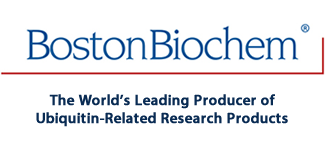
Recombinant Human His6-Use1/UBE2Z Protein, CF Summary
Product Datasheets
Carrier Free
CF stands for Carrier Free (CF). We typically add Bovine Serum Albumin (BSA) as a carrier protein to our recombinant proteins.Adding a carrier protein enhances protein stability, increases shelf-life, and allows the recombinant protein to be stored at a more dilute concentration.The carrier free version does not contain BSA.
In general, we advise purchasing the recombinant protein with BSA for use in cell or tissue culture, or as an ELISA standard.In contrast, the carrier free protein is recommended for applications, in which the presence of BSA could interfere.
E2-677
| Formulation | X mg/ml (X μM) in 50 mM HEPES pH 7.5, 200 mM NaCl, 10% Glycerol (v/v),1 mM TCEP |
| Shipping | The product is shipped with dry ice or equivalent. Upon receipt, store it immediately at the temperature recommended below. |
| Stability & Storage: | Use a manual defrost freezer and avoid repeated freeze-thaw cycles.
|
Reconstitution Calculator
Background: Use1/UBE2Z
Uba6-specific E2 Conjugating Enzyme 1 (Use1), also known as Ubiquitin-conjugating Enzyme E2Z (UBE2Z), is a member of the Ubiquitin-conjugating (E2) enzyme family that is highly expressed in human placenta, pancreas, spleen, and testis (1). Use1/UBE2Z has a predicted molecular weight of 38 kDa. The human enzyme shares 98% amino acid sequence identity with its mouse and rat orthologs. It has an E2 catalytic core domain that contains an active site cysteine residue that is required for the formation of a thioester bond with Ubiquitin (2). Use1/UBE2Z functions specifically with the UBE1L2/UBA6 Ubiquitin-activating (E1) enzyme, rather than the UBE1 E1 enzyme, for Ubiquitin conjugation (3). Use1/UBE2Z expression is enriched in the cytoplasm where it mediates the ubiquitination of RGS4 and RGS5 via the N-end rule proteolytic pathway (4). Use1/UBE2Z also functions with UBE1L2/UBA6 to mediate the conjugation of HLA F-associated Transcript 10 (FAT10), a Ubiquitin-like protein, and is auto-FAT10ylated in response to TNF-alpha and IFN-gamma (5). This protein has an N-terminal His6-tag.
- Gu, X. et al. (2007) Mol. Biol. Rep. 34:183.
- Hershko, A. et al. (1983) J. Biol. Chem. 258:8206.
- Jin, J. et al. (2007) Nature 447:1135.
- Lee, P.C. et al. (2011) Mol. Cell 43:392.
- Aichem, A. et al. (2010) Nat. Commun. 4:13.
FAQs
No product specific FAQs exist for this product, however you may
View all Proteins and Enzyme FAQsUbiquitin E3 Ligase Kits
Human CHIP Ubiquitin Ligase Kit - Glow-Fold Substrate
Reviews for Recombinant Human His6-Use1/UBE2Z Protein, CF
There are currently no reviews for this product. Be the first toreview Recombinant Human His6-Use1/UBE2Z Protein, CF and earn rewards!
Have you used Recombinant Human His6-Use1/UBE2Z Protein, CF?
Submit a review and receive an Amazon gift card.
$25/€18/£15/$25CAN/¥75 Yuan/¥1250 Yen for a review with an image
$10/€7/£6/$10 CAD/¥70 Yuan/¥1110 Yen for a review without an image
ebiomall.com






>
>
>
>
>
>
>
>
>
>
>
>
我转的是7901、7901/DDP两种细胞,前者7901细胞很容易就转上,并且转后,状态良好,可是7901/DDP一转就死,我用的是吉玛慢病毒,转24小时后换液,刚开始一两天,没有异常,但后来细胞慢慢就死了,并且不是漂浮的,很多是贴着壁死,像是瓦解了一样
这是未转时细胞的样子
这是细胞转后,死亡的样子
并且即使是有些细胞未死,细胞后来也变得很脏,感觉有很破碎的细胞碎片
本人实验小白,**园子里大神指点,急,实在不知道怎么回事
细胞状态与密度;转染试剂的类型、用量;DNA的品质、用量;转染复合物的品质、作用细胞的时间长度。
GFP发出绿色荧光的原理是Ca离子进入GFP的beta-barrel结构中引起的特定能级,因此只要这个结构仍然保持着,就可以发出荧光。
由于GFP的beta-barrel结构非常稳定,一些版本的GFP蛋白(如EGFP)甚至能抵抗94C的高温几分钟而不完全变性,因此想在溶液状态下去掉GFP的荧光是很难的,一般需要用光漂白法。
基于其非常稳定的结构,即便细胞被固定了,仍然会有一部分的GFP蛋白保持其构象而发出荧光。此时荧光可能较弱。在荧光显微镜下是有可能看得到的。
DXY721认为:
悬浮细胞和贴壁细胞在转染过程中差别不大,主要差别在于转染后的筛选,当然如果你做的是瞬时转染就不存在筛选的问题了。
其实转染的过程很简单,问题是能不能转的进去的,转染率能有多少,转进去是否可以稳定表达目的蛋白等等。
我们也是用脂质体做悬浮细胞的转染,说明书上都有具体的操作过程,将脂质体和目的基因按比例混合,然后加到细胞悬液里就OK了,说的简单,实际上还是有一些细节要注意的,比如脂质体和目的基因混合的比例,转染的细胞数,细胞的代数,细胞的状态,有的还要求在转染的前一天传代一次,不过不要怕,这些在脂质体说明书上都有明确的说明,按照说明书做就可以了。
jinghuanlv认为:
悬浮细胞和贴壁细胞转染还是有很大不同的。
脂质体转染的原理基于电荷吸引原理,先形成脂质体-DNA复合物,散布在细胞周围,然后通过细胞的内吞作用,将目的基因导入细胞内,而脂质体复合物与贴壁细胞的接触机会比悬浮细胞高出很多倍,所以,脂质体转染时悬浮细胞的转染效率要明显低于贴壁细胞。
我们实验室转染悬浮细胞是用的电穿孔法,目前为止,悬浮细胞转染的最好方法还是电转,我们实验室用的电转仪是Bio-Rad的,使用条件是电压250V,电容975uF,效果不错,不妨一用。









